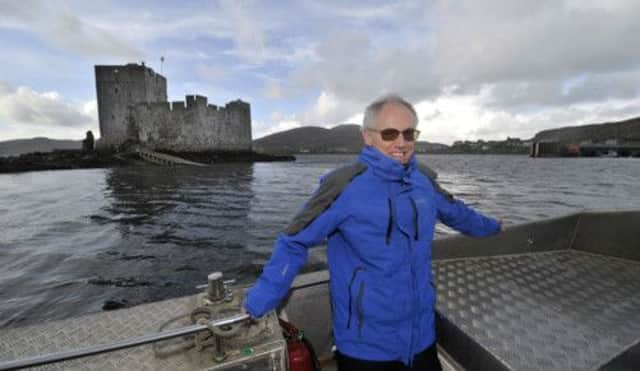Kisimul Castle conservation deal agreed


Kisimul Castle, perched on a rocky islet off Castlebay on the Hebridean island of Barra, is the ancient seat of the Clan Macneil and the symbolic home of the Clan around the world.
One of the most photographed castles in Scotland, it passed into the care of Historic Scotland 13 years ago on the basis of an annual rent of £1 and a bottle of Talisker malt whisky being paid to the Macneils.
Advertisement
Hide AdAnd today Historic Scotland announced that agreement has now been reached between the agency and Rory Macneil, the 47th Clan Chief, on a £200,000 scheme to preserve the ruined fortress for future generations.
Half the finance is coming from funds donated by Clan Macneil members across the globe.
A spokesman for Historic Scotland explained: “The work represents a unique opportunity to conserve and secure the site for current and future generations. It will also result in an improved visitor experience and ensure that the fabric and structure of the castle are conserved for years to come. Gaelic will be a key consideration in the interpretation that will be developed for the site.
”
Macneil of Barra, whose father transferred the ownership of the castle to Historic Scotland in 2000 on a 999 year lease, said: “Agreement on the conservation plan is a milestone in the long and varied history of Kisimul Castle. It opens the door to completion of the immediate projects covered by the plan and long term conservation of this unique structure.
“This plan will help ensure that Kisimul continues to play a central, symbolic and economic role in Barra and Vatersay, and to serve as an inspiration to Macneils around the world. I would like to express my gratitude to clanspeople whose contributions to the Kisimul Castle restoration fund can now be put to good use, and to Historic Scotland for its stewardship of the Castle over the past 13 years and the positive way in which it is engaging with the Barra and Vatersay community.”
Ian Walford, Chief Executive of Historic Scotland said: “Kisimul Castle is a true icon of the Western Isles, representing Barra’s rich, colourful and sometimes turbulent history. There are few castles of this nature in Scotland, sitting proud in the island’s main harbour and for most visitors it is their first experience of Barra’s historic environment.
”
Advertisement
Hide AdThe conservation plan was also welcomed by local community leaders and politicians
Alasdair Allan, MSP for the Western Isles, said: “Anyone who has been to Barra, and taken the small boat across the water to Kisimul castle will know it is located in such an atmospheric and romantic setting. The “castle in the sea” is loved by both visitors from around the world and the local community alike.
Advertisement
Hide Ad“It is a surviving symbol of Gaeldom and now this management plan will ensure its survival.”
Local councillor Donald Manford said: “The community of Barra and Vatersay has taken Kisimul Castle to its heart in a way that’s difficult to quantify. Historic Scotland are to be commended for the way they have understood and strengthened this special relationship.”
And Angus MacNeil, MP for the Western Isles said: “This is a fine sum of money being spent in Barra on the iconic Kisimul Castle and it is all the more impressive that half of it was raised from the Macneil Diaspora across the world.
“The current chief Rory Macneil and his late father, the much loved Ian Roderick Macneil and 46th Chief, deserve great credit for fostering these links. The castle is a marvel of both natural and human creation and this money helps it to see its second millennia.”
Archaeological excavations, commissioned by Historic Scotland earlier this year, have already uncovered Iron age pottery, flint cores and animal bone. at the site. As part of the conservation scheme further work will be carried out to discover more about the castle’s history, how it was used and the history of the earlier occupation of the Islet on which the castle sits.
The Macneils are said to have first settled on Barra in the 11th century and the islet is believed to have been first fortified in the 15th Century.
Advertisement
Hide AdKisimul was abandoned in 1838 when the island was sold and the castle began to deteriorate. Some of its stone was used for paving in Glasgow.
The remains of the castle were bought in 1937 by the then clan chief of the Macneils who began efforts to restore the castle.